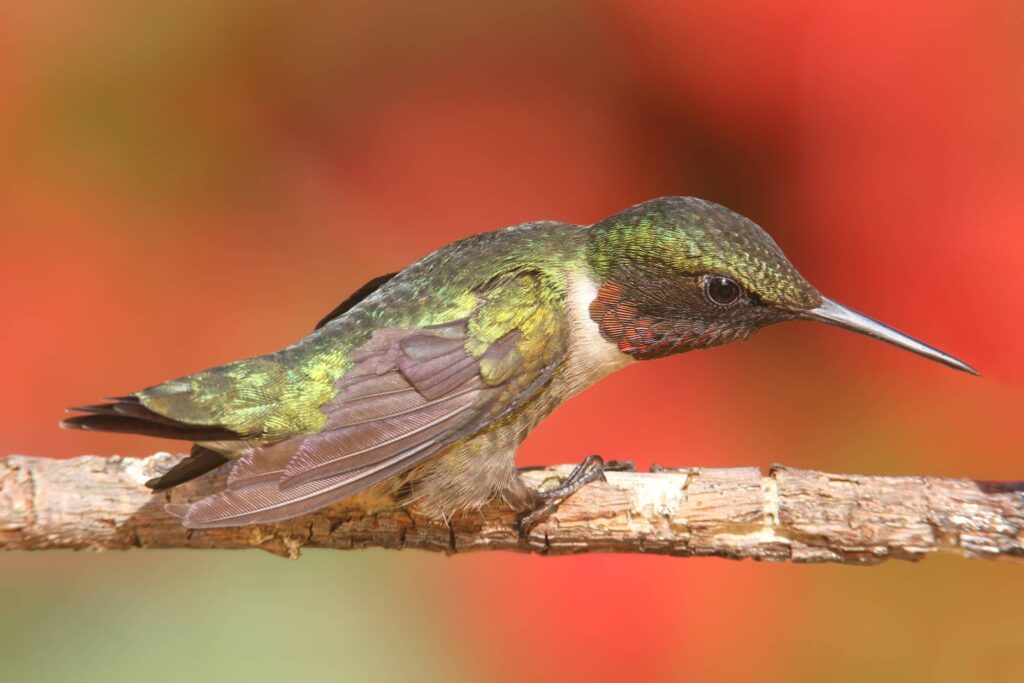Virginia’s Chesapeake Bay and the Blue Ridge Mountains shape its climate and geography and provide habitation for much of its animal and plant life.
If you had to travel this state from east to west, you would pass through five geographical areas: the Appalachian Ridge and Valley, The Blue Ridge, the Appalachian Plateau, Piedmont, and finally, the Atlantic Coastal Plains.
Hidden in these differing geographical areas is an abundance of plants and animals. Among the animals, you can find 75 different species of mammals, 226 freshwater fish species, 350 species of estuarine and saltwater fish, and 422 bird species, of which 359 are regular visitors; including many species of hummingbird.
Hummingbirds You Can Find In Virginia
There are eight different species of hummingbird that you can find in Virginia. One is a native breeder, one is a regular visitor, and six are rare visitors.
Ruby-Throated Hummingbird
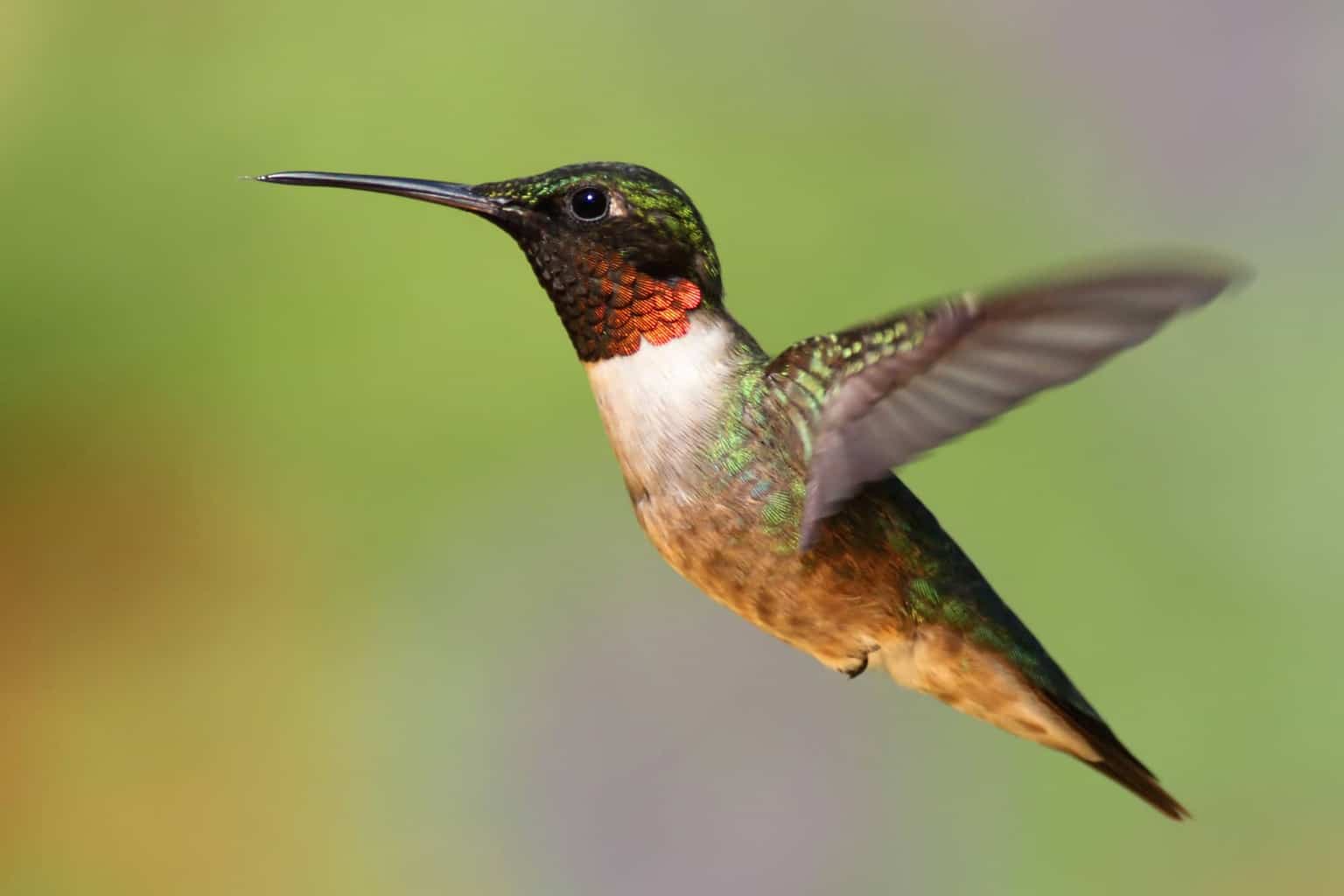
- Scientific Name: Archilochus colubris
- Length: 8 – 3.5 inches
- Weight: 071 – 0.212 ounces
- Wingspan: 1 – 4.3 inches
Description:
The adult male and female Ruby-throated Hummingbirds have iridescent green-bronze backs, crowns, napes, and two middle tail feathers.
They have greyish-white abdomens, and dark outer tail feathers and wings, with a hint of purple in the coloration.
The adult male has an iridescent ruby-red throat patch, green sides, grey chins, and slightly forked dark-colored tails.
The females, larger than the males, have brownish sides, whitish throats and chests, and rounded tails.
Additional Information:
The Ruby-throated Hummingbird is a native breeder in Virginia and therefore is the most commonly seen hummingbird in the state.
Hummingbirds usually arrive in Virginia around the middle of April, and most have left by the beginning of October.
Ruby-throated Hummingbirds have the most extensive breeding grounds in North America, and they are the only native breeding hummingbirds in the Eastern United States.
The male and female Ruby-throated Hummingbird will aggressively defend their territories from other hummingbirds, and this can often lead to spectacular chases with the occasional jab with the beak.
Rufous Hummingbird
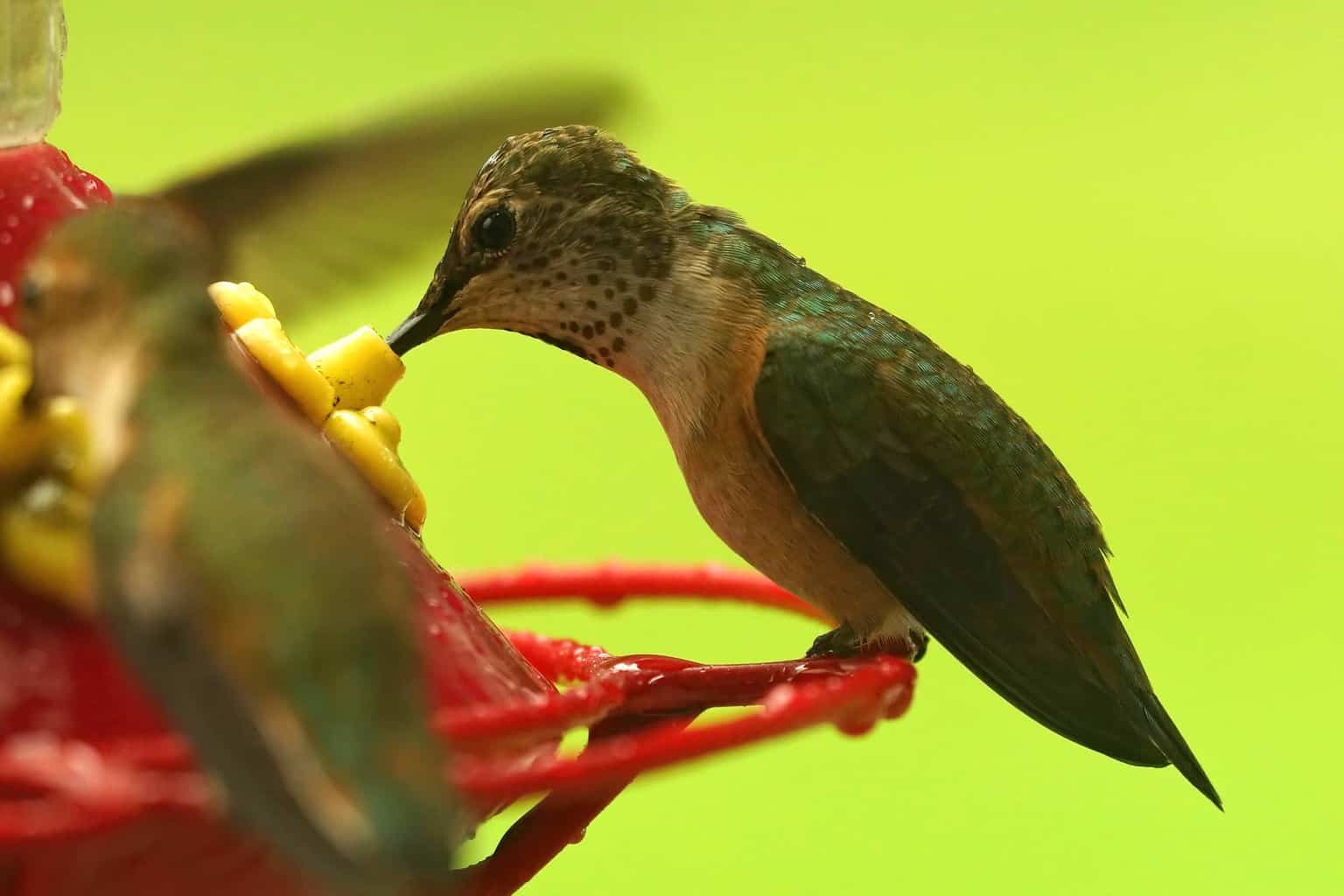
- Scientific Name: Selasphorus Rufus
- Length: 1 inch
- Weight: 071 – 0.176 ounces
- Wingspan: 3 inches
Description:
The adult male Rufous Hummingbird typically identified by his iridescent red-orange throat patch, has a reddish-brown face, upper plumage, side, and black-tipped tail. His abdomen, chest, and throat are creamy white.
The adult female has a bronzy-green back and crown with some white. Her otherwise white throat has iridescent orange streaks in it. Her chest is whitish, and her sides are reddish-brown. She has a white-tipped, dark tail with a rufous base.
Additional Information:
The Rufous Hummingbird is a regular visitor to Virginia and is one of North America’s most widespread hummingbirds. It can be observed in every province and state except for Prince Edward Island, Hawaii, and Quebec.
The western Rufous Hummingbirds’ migration leads it through the Rocky Mountains from May to September while it takes advantage of the wildflower season. If they decide to stay in one local region during the summer, they will often aggressively defend and take over feeding locations.
The Rufous Hummingbird’s migratory journey is one of the longest journeys for its tiny body size, traveling roughly 3,900 miles from Alaska to Mexico; this is a fantastic feat for a bird of only about 3 inches long!
Calliope Hummingbird
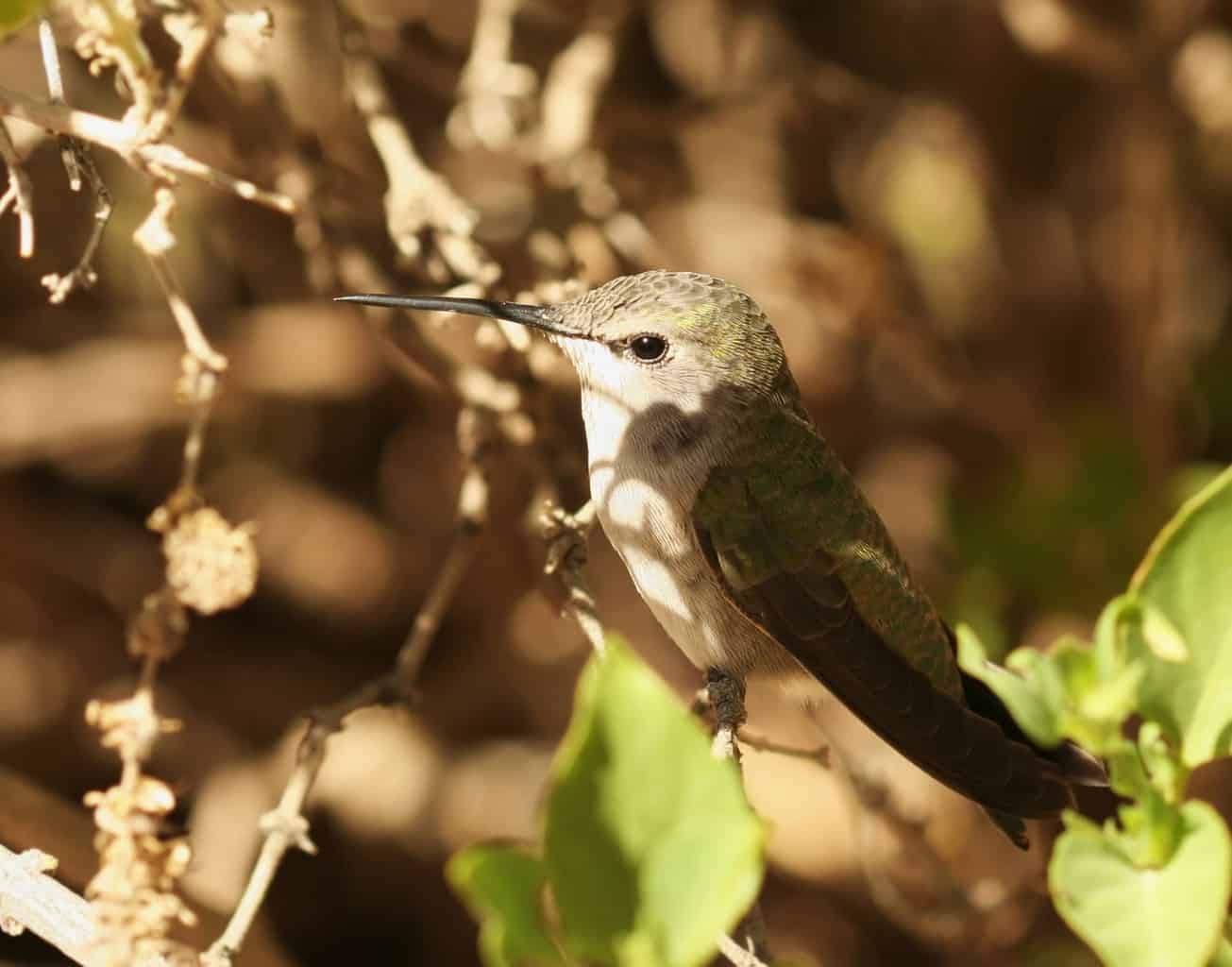
- Scientific Name: Selasphorus calliope
- Length: 8 – 3.9 inches
- Weight: 071 – 0.106 ounces
- Wingspan: 3 inches
Description:
The adult male and female Calliope Hummingbirds have glossy-green backs and creamy-white underbellies. Their tails and beaks are relatively short. The females have dark streaks on their whitish throats.
The males have elongated iridescent purple-streaked or wine-red throat feathers that have a whiskered effect when erected. Males also have green sides and dark tails compared to their female counterparts with pinkish sides and white-tipped dark tails.
Additional Information:
The Calliope Hummingbird is a rare visitor to Virginia, with only a handful of sightings on record.
These hummingbirds are migratory birds, generally leaving their nesting grounds earlier than most other hummingbirds. They take advantage of the late-summer wildflowers they find on their route through the western North American mountains.
The Calliope Hummingbird is the United States and Canada’s smallest breeding bird, weighing around one-third as much as the smallest of the North American warblers. It is also the world’s smallest long-distance migrant, traveling approximately 5,000 miles on its migration journey each year.
Allen’s Hummingbird
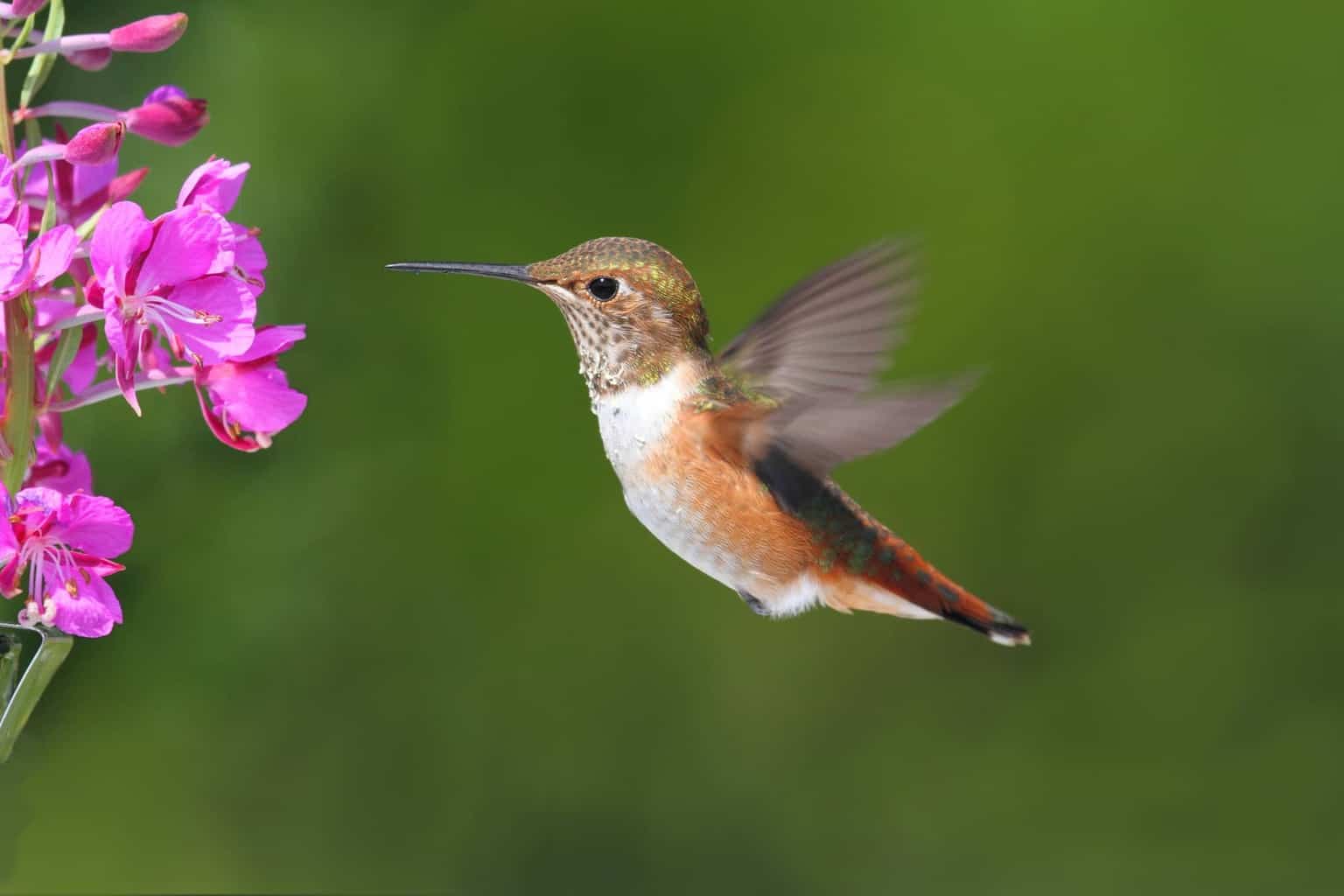
- Scientific Name: Selasphorus sasin
- Length: 3 – 3.5 inches
- Weight: 1 ounce
- Wingspan: 3 inches
Description:
The adult males have rufous colored sides and lower backs. Some males might have orange lower backs and iridescent red-orange to red-copper throat patches. His feathers are elongated and project slightly to the sides. He also has a white spot behind his eyes.
The female has similar coloration but lacks a bright throat patch. Instead, her throat patch is speckled and has a few red feathers in some cases.
Additional Information:
Allen’s Hummingbirds are rare visitors to Virginia. Historically these hummingbirds were coastal California nesters, and they would winter in Mexico. However, more and more are now spending their entire year in California, with a few even traveling to the eastern United States for their winters.
These hummingbirds are early migrators, preferring to leave their wintering grounds as early as December, arriving in time for the abundant flowers produced by the rains in January.
The adult males are highly aggressive and territorial, chasing away any other male that might enter their breeding area; records state they have even chased away predatory birds such as hawks and kestrels.
Black-Chinned Hummingbird
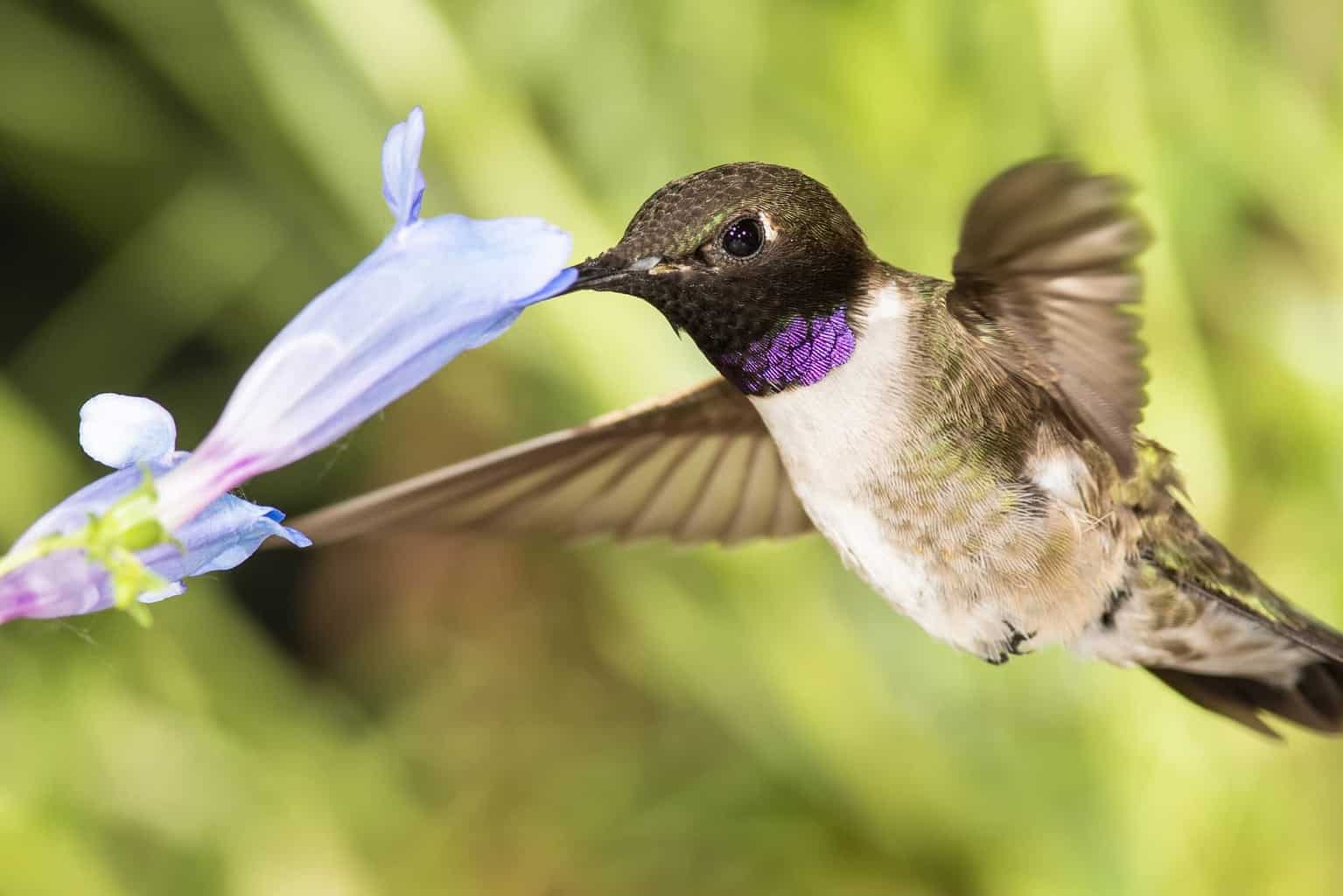
- Scientific Name: Archilochus alexandri
- Length: 25 inches
- Weight: 1 – 0.2 ounces
- Wingspan: 3 inches
Description:
The male and female Black-chinned Hummingbirds have metallic-green backs and white bellies with green sides. They have straight, long, and slender bills.
The males have black chins and faces, glossy purple throat bands, with white collars below. They also have white spots behind their eyes.
The adult females have whiteish bellies and dull metallic-green sides. Their dark outer tail feathers are white-tipped.
Additional Information:
Black-chinned Hummingbirds are rare visitors to Virginia, and there have not been that many recorded sightings.
These hummingbirds can be found as far south as Mexico, in most areas in the western United States, east to Oklahoma, and in British Columbia and Alberta in Canada.
They feed primarily on nectar but eat spiders and insects as a good protein source. During their nectar harvesting, the Black-chinned Hummingbird assists in plant pollination.
If the temperatures drop too low, these little birds will put themselves into a state of torpor, slowing their heart rate and metabolic rates. While they are in this state, they will breathe sporadically.
Anna’s Hummingbird
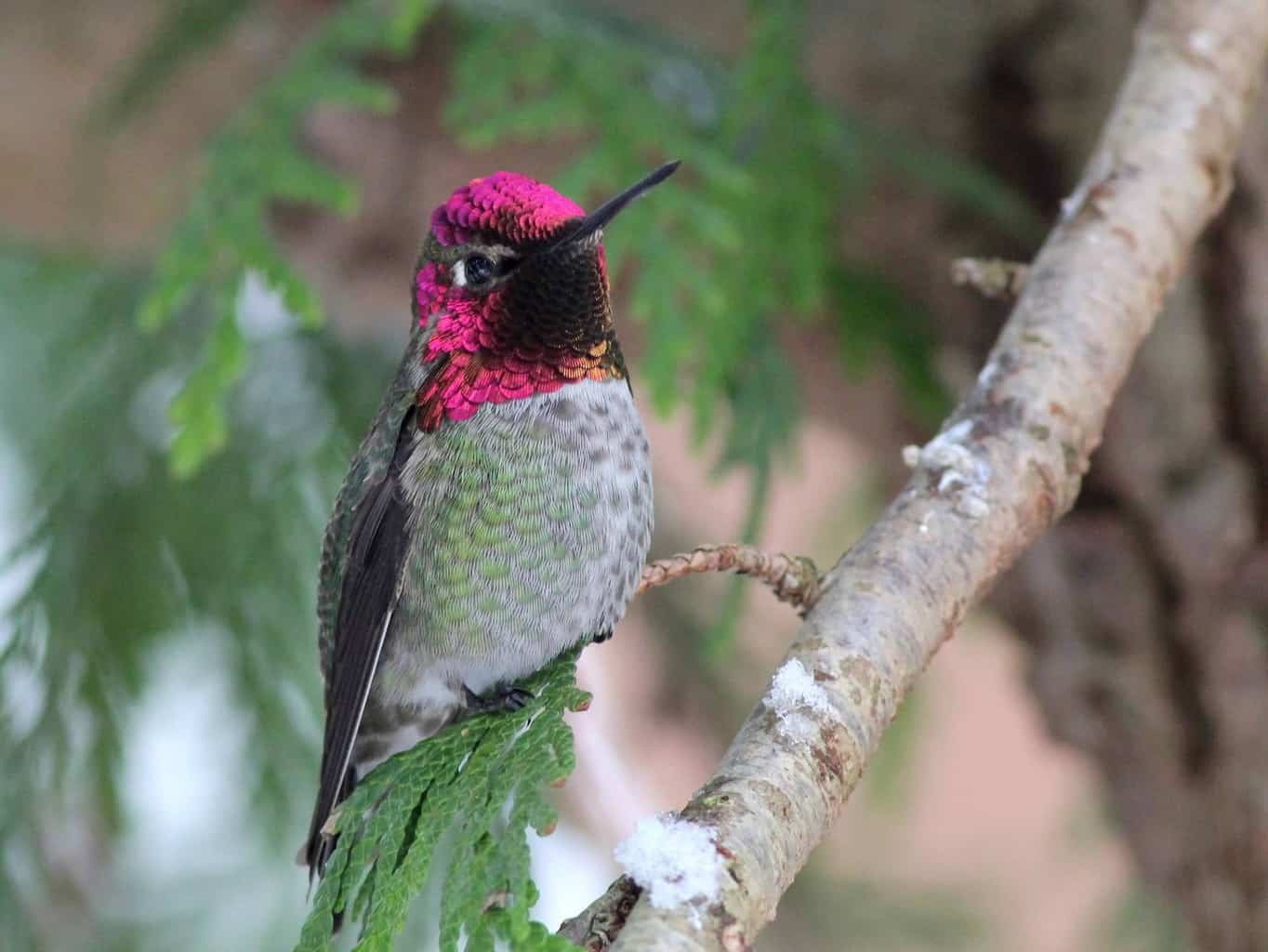
- Scientific Name: Calypte anna
- Length: 9 – 4.3 inches
- Weight: 1 – 0.2 ounces
- Wingspan: 7 inches
Description:
Male Anna’s Hummingbirds are easily recognizable by their rose-pink crowns and throat patches; this coloration can appear dark purple or black in low lighting.
Their elongated feathers project down the sides of their necks. They have metallic green bronze backs and sides; their tails are black or dark, except for the central pair, which are green.
Adult females have green backs and greyish-white or greyish-brown tummies with some green spots. Her rump tufts are white, and her head is sometimes dark brownish-grey; her throat has red spotting, forming a small irregular patch, and she has a rounded dark tail with green central feathers.
Additional Information:
Anna’s Hummingbirds are infrequent visitors to Virginia with only one or two sightings on record. They are more common along the Pacific Coast, where they breed and spend their winters.
At the beginning of the 20th century, Anna’s Hummingbirds would only breed in southern California and northern Baja California. However, due to the planting of exotic flowering trees in backyards that provide nesting sites and nectar, these hummingbirds have expanded their breeding ranges.
The male Anna’s Hummingbird has a fantastic dive display that he performs during the courting ritual. He starts his show by hovering 6 – 13 feet in front of his audience. Then, he plummets in a near-vertical dive before ending off with an explosive squeak within 1.5 feet from his audience and returning to his original position in a circular arc.
Rivoli’s Hummingbird
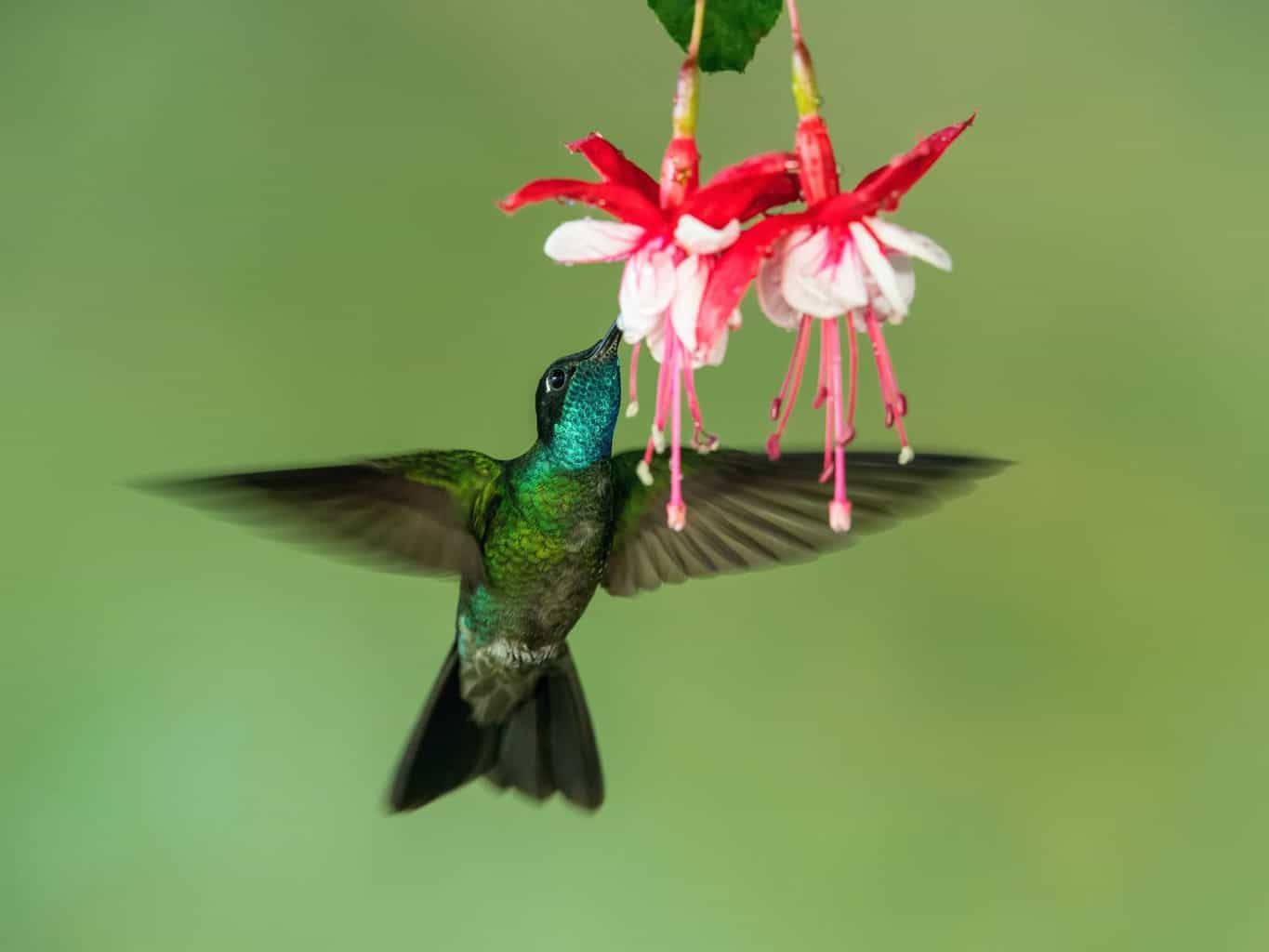
- Scientific Name: Eugenes fulgens
- Length: 3 – 5.5 inches
- Weight: 2 – 0.3 ounces
- Wingspan: 1 inch
Description:
The adult male Rivoli’s Hummingbird is primarily identified by his iridescent bright green-blue throat patch. He has a black head except for his violet crown and the white stripes behind his eyes. He has a glossy bronze-green back, which gets more bronze towards his tail, his chest is bronze-green, and his tummy is greyish.
The adult female has a bronze-green back and a soft grey tummy. Her throat is a grey color with light streaking, and she has greyish white tips on her dark tail, with the same white stripes behind her eyes that the male has.
Additional Information:
Rivoli’s Hummingbirds are rare visitors to Virginia, with only a few on record for visiting the state. These hummingbirds are easily recognizable as they are almost twice as large as any other hummingbird species that you can see in this state.
Rivoli’s Hummingbird had its name changed to Magnificent Hummingbird in 1983. In 2017 they decided to split the species in two, returning Rivoli’s name and naming the second species Talamanca Hummingbird.
The Rivoli’s Hummingbird is North America’s second-largest hummingbird, with only the Blue-throated Hummingbird that is larger. Even though it is bigger than most other species of hummingbirds, it does not push any other hummingbird around near flowers or feeders.
Violet-Crowned Hummingbird
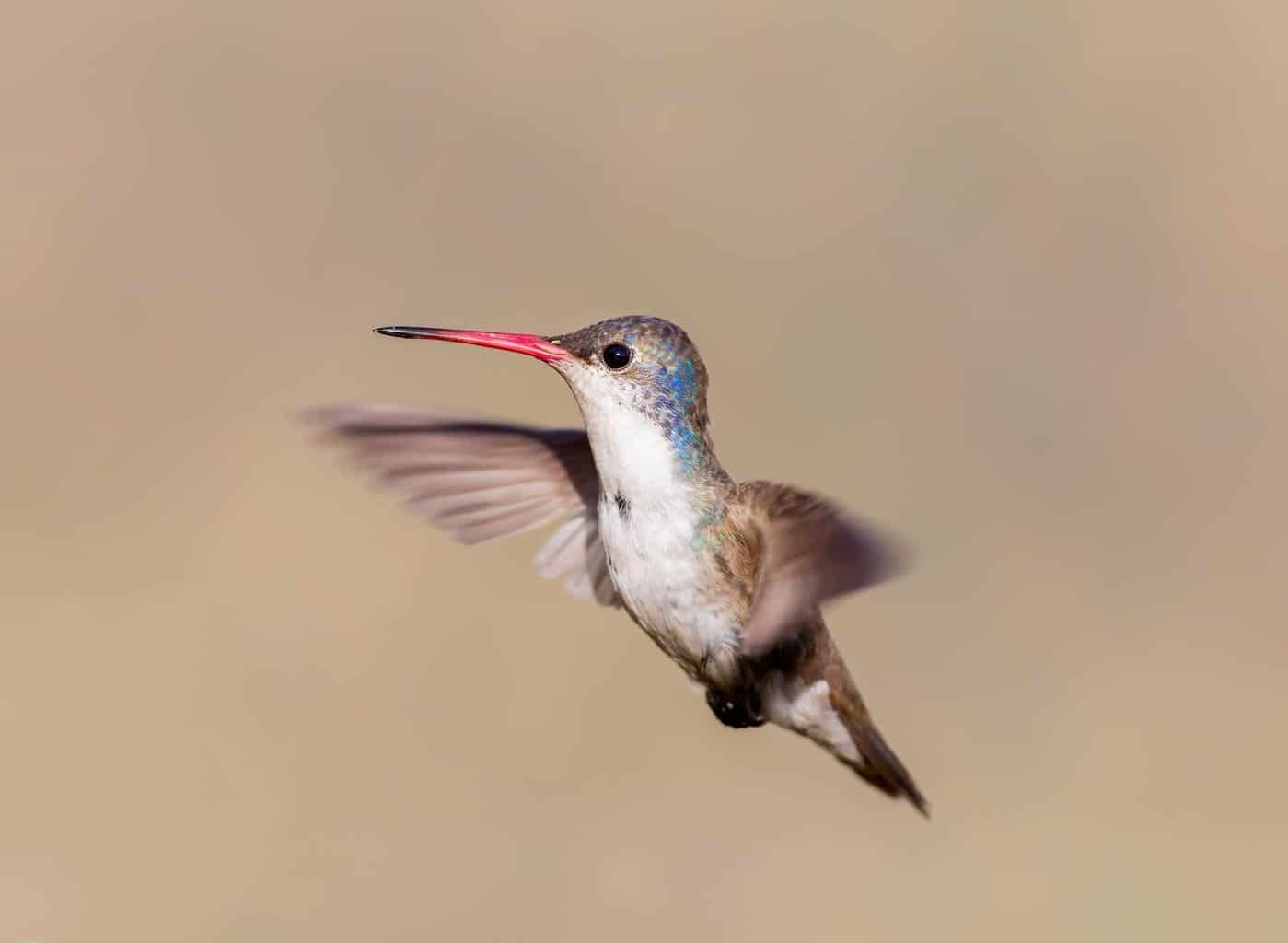
- Scientific Name: Leucolia violiceps
- Length: 4 inches
- Weight: 18- 0.2 ounces
- Wingspan: 5 inches
Description:
The Violet-crowned Hummingbird has a white under-plumage and an iridescent violet-blueish crown. It has an emerald green back and an olive green / dark brown tail. Its bill is slender and straight and is orangey-reddish with a black tip.
The adult female resembles the adult male, but her plumage is generally less colorful, and her crown is greener but lighter than the male.
Additional Information:
The Violet-crowned Hummingbird is a rare vagrant to Virginia, primarily found in the south-central to the southwestern United States and Mexico. However, in recent years they have traveled as far as Virginia.
They are typically mountain dwellers, and their preferred habitats include arid scrub, canyons, and streamside growth. They feed on nectar and some insects hovering while they forage.
Violet-crowned Hummingbirds are said to make loud chattering sounds. Males establish territories in their feeding grounds which they defend aggressively.
Conclusion
Of the eight species of hummingbirds that are on record for visiting Virginia, only two are native or common visitors. Luckily there are many other species of birds to view in this state during the rest of the year. This list will show you which different species of birds you might be able to see while visiting Virginia.

